Seeking to advance your skills as a harpist and musician? Your search ends with these 10 top tips on How To Play the Harp, which will guide you in mastering a piece accurately and swiftly!

Choosing Repertoire
ONE
Choosing repertoire is an exciting part of learning the harp, and there’s nothing better than feeling the spark of excitement that inspires you to practice.
Choose music that’s within your technical ability but, more importantly, choose music that makes you happy, because an audience will feel that enjoyment when you perform.
Find an audience!
TWO
Performing for an audience instead of just your teacher is an important part of learning an instrument for reasons such as gaining confidence in yourself, improving stage presence and learning to think on your feet (expect the unexpected!).
Get to know your local churches, where concerts happen regularly, and music societies. Once you start looking you’ll find many performing opportunities in the community.
Think of a public performance as something that requires practice, and the more you do it the better you get at performing for an audience.
Warming Up
THREE
I know what you’re thinking; you don’t have time to warm up. You want to get straight into learning your new notes. We all do, but ensuring you have warmed up will enable you to perform at your best.
Warm ups don’t need to be fast, but try covering a variety of techniques that occur in your pieces. These can include scales, arpeggios, chords, jumps and harmonics. You can experiment with varying rhythm in order to keep your mind engaged.
As well as warming up your hands and fingers before playing, think about posture, and other parts of the body that need warming up, including your feet, neck, shoulder, wrists and fingers!
Write Down Practice Goals
FOUR
Always go into the room knowing what you’re going to practice, in which piece and how. You will soon notice the quality of your session improving and you won’t need to spend so much time at the harp.
Identify the phrase or technique that’s causing problems, and decide on a way to improve it. Always ask yourself “is this the best way of improving it?”.
It’s easy to get carried away in the music when you practice, and you may not have a huge amount of time during the day, so knowing which parts amd techniques need improving before you start will help you work efficiently.
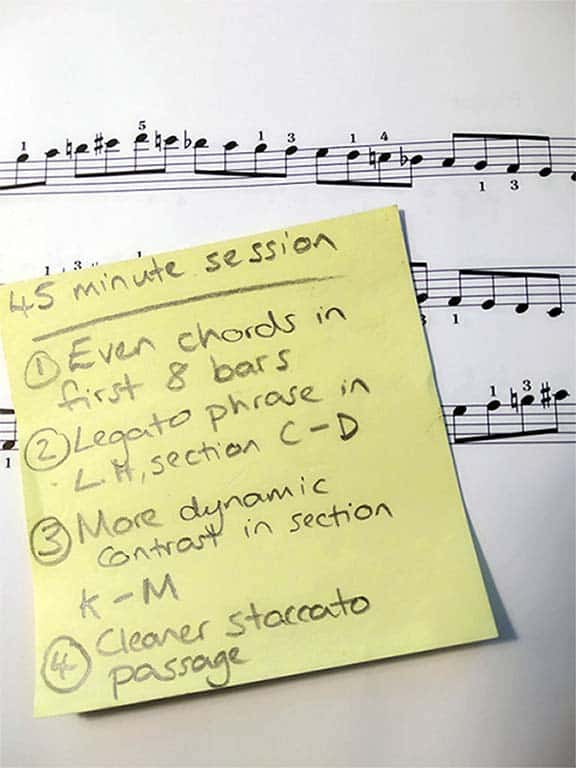
Start at the end
FIVE
As musicians and players, we naturally tend to start practicing a piece from the beginning resulting in a great opening, but have you tried practicing the ending notes of the piece and working your way backwards?
You’ll often find the ending phrase of a piece more challenging than the beginning sections, so it’s good to get a head start on tackling that triumphant finale.
Slow Practice
SIX
You may need a strong mind, but slow practice is an excellent way of committing a piece to fingers and mind.
The slower you’re playing each note the more time you have to think about fingering, hand position, harp technique, articulation, rhythm, and phrasing. Before you know it, you can already play the piece from memory!
Start small, with focus on small sections such as the first phrase of the piece. This will gradually build your confidence until you can eventually tackle the whole piece.
Remember, both hands may need individual attention!
This is where a metronome comes in handy! Begin with a speed that’s roughly half the marked tempo, and when you’re ready to move to the next speed, increase the tempo by 5 bpm.
Korg MA-2
metronome
Multi-function compact metronome
-
Up to: 400 hours of continuous operation
-
Display: Larger and more easily readable display
- Enhanced volume and crisp sound for easier detection
- Equipped with 'timer' & 'sound out mode' for daily practicing
- Available in two colours: black and red, or blue and black
- Has a Tap Tempo function, making it super easy to use
- Earphone jack with adjustable volume
- Stylish display
- Compact - so easy to travel
- None!
Pedal Power
SEVEN
There aren’t many instruments that require foot and hand movement simultaneously, but the harp is one of them.
Pedal harp: it’s always good to practice our feet alone, in the same way you would practice one hand at a time and try to find ways of perfecting your pedal technique.
Marking up your pedals: It’s entirely up to you where and how you place pedal markings on your score, but the best tip for clean (no buzzing or jarring) pedal changes is spreading them out as much as possible.
Once you’ve marked your score with the correct pedal changes, practice moving the pedals alone whilst humming the written notes. That way you don’t need to concentrate on your fingers and hand movements at the same time as the rhythm of your feet!
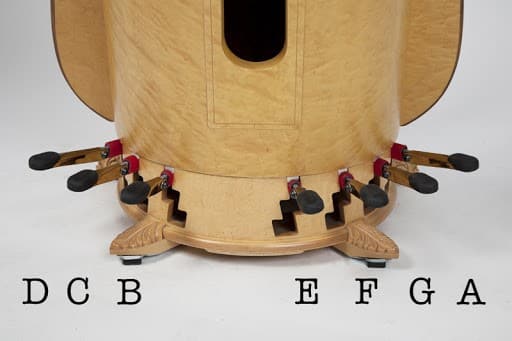
THAT’S the sound I want
EIGHT
Harpists spend a lot of time working on their sound, and that sound will most likely differ from harpist to harpist.
From the moment you start your warm ups, listen to each individual note ensuring there isn’t a nail zing or a finger buzz in sight, and don’t stop listening and striving for THAT sound.
How about recording yourself playing? No need for fancy equipment, your phone is perfect. Listening to yourself without the distraction of playing will open your ears and mind to another level.
Take Breaks
NINE
Don’t overwork your brain and body.
Find a length of practice session that works for you. Be strict with yourself and stick to it.
There’s no benefit in trying to power through a two hour practice session, because at some point your brain will begin to get fatigued, and meaningful practice will then be impossible.
Start with a phrase or two and if you find you need to walk around for a minute in order to refresh your mind, do!
‘Relax!’ is the worst thing to say to a tense person!
TEN
When you’re playing the harp have you ever thought about your lungs? No; why would you if you use your hands and fingers to play?!
When we are tense our breathing can become shallow, which directly impacts the way we play due to the tension in our muscles. Whilst you practice slowly, one note at a time, try taking deep breaths in and out in order to instill the habit. Breathing is something else we need to practice, believe it or not!
How to play the harp – 10 top tips
Summary
These top ten tips will get you started on your journey with the harp. Keep them ‘in the bank’ and don’t forget to add to it with every discovery you make when you practice.
Learning to play music takes time and patience, keep striving for excellence and remember to enjoy yourself!
Do you want to share this infographic on your site? Use this code...
FAQ's
Like most things in life, there are difficult things and easy things about learning the harp. My advice: don’t overthink it, and enjoy learning and sharing your music with others!
- Sit with the back of the harp (the part with elongated holes) facing you
- Tilt the harp towards you right shoulder
- Rest the harp on the inside of both knees
- Place your finger/s on the strings and play! (N.B we don’t use the little finger on either hand when playing the harp; and the thumb is finger 1)
Choose a harp you can physically manage, in terms of playing and transporting! If you decide to buy a lever harp first, I would advise you not to buy anything smaller than a 36 stringed instrument.
It will take you less than five minutes to learn to play a simple version of Twinkle Twinkle Little Star with one finger, but for a complete beginner with no previous experience or knowledge of playing an instrument or reading music, then you’re looking at the best part of one to two years, depending on your age.
You can tune the harp yourself. Get yourself a tuning key and a tuning machine and watch this ‘how to’ video for lever harps and this video for pedal harps!
Yes! I’m afraid long nails and the harp aren’t the best of friends! Keep your nails on each hand short enough that they don’t hit the string when you pluck.



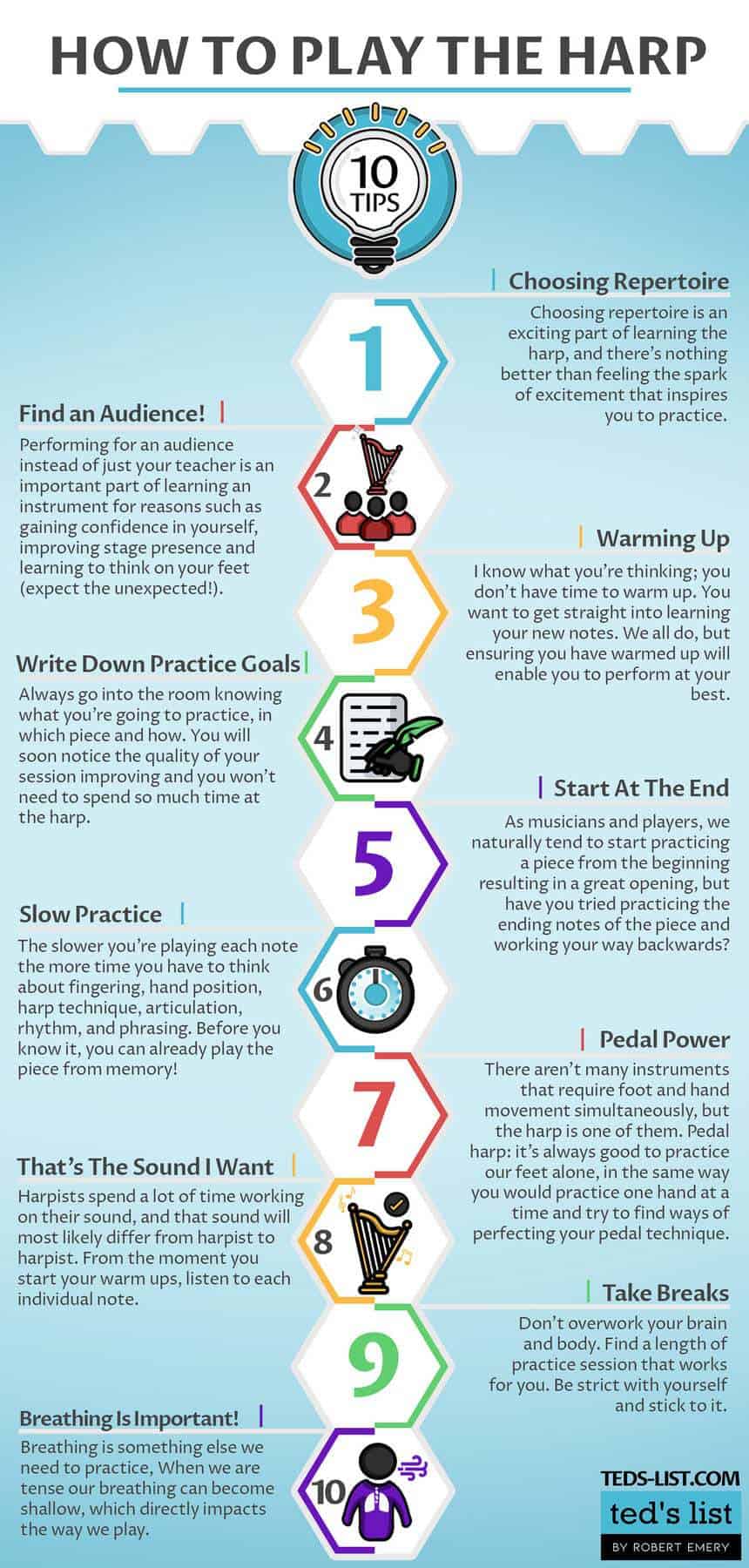
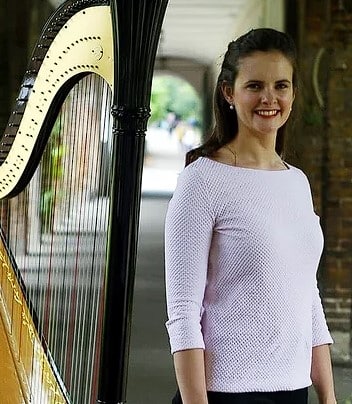






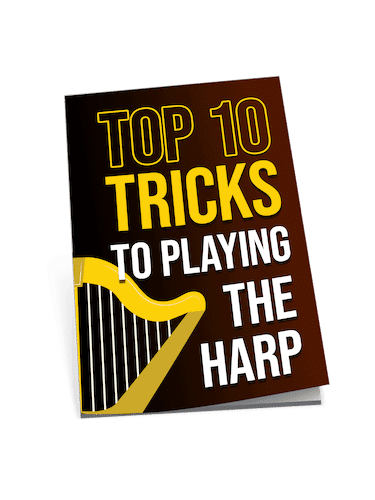
Saw the mention of the Korg MA-2 metronome and had to jump in! That’s my go-to for practice sessions. It’s like, totally changed how I approach warming up and practice routines. Anybody else got cool gadgets they use for practice? I’m always on the lookout for tools that make the grind a bit more interesting, especially for those long practice sessions where keeping tempo becomes a brain melt.
The section on ‘Slow Practice’ is fundamental. Many overlook the importance of this stage in mastering an instrument. It builds muscle memory and accuracy. It’s encouraging to see it emphasized here.
I’ve been trying to get the pedal positions right for ages! Every time I think I’ve got it, something seems off. Does anyone have tips for mastering pedal power? It’s like, I know what sound I want to achieve, but translating that into my footwork is proving to be way harder than I expected. Also, how often do you guys actually practice this part? I feel like I’m missing something key here.
omg, glad i’m not the only one struggling with this. thought it was just me being a noob.
Hey Elly, practice is key! Try slowing down your movements to ensure accuracy before speeding up. Also, thinking of the pedals as an extension of your musical expression rather than a mechanical task can help. Keep at it!
The Harp is such a beautiful instrument. I am hoping to play it as skillfully as those before me!
Dorothea, the harp is the most amazingly beautiful instrument. Good luck with your playing…